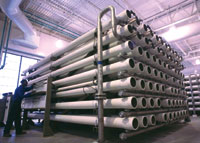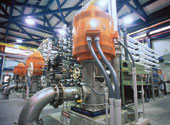 |
| GOING INSIDE Open site plans may end as plant designers opt for enclosed plants. |
The ominous discovery of U.S. water system plans at an Al Qaeda hideout in Afghanistan two years ago brought home stark new realities facing water agencies. Utility officials and consultants say that the upgrades completed since 9/11 represent only the beginning of far-reaching changes in planning, procurement, design, technology and budgets.
"Youre just going to see security issues entering into every part of our business as well as every part of our clients business," predicts Deborah English, engineering manager for Kansas City-based Black & Veatch.
Utilities are prepared to invest heavily in security, says Tom Curtis, deputy executive director for government affairs in the Washington, D.C., office of the American Water Works Association. One major western system has earmarked $80 million for security-related measures, he says. Agencies must find the money either by rate hikes or by deferring other capital projects, Curtis predicts.
SAFETY CHECKS
Much work will emerge primarily from the federally mandated vulnerability assessments that water systems serving at least 50,000 customers completed this year. The implications of those assessments for capital planning "are just now shaking out," says Brian Ramaley, director of Newport News (Va.) Waterworks.
For most utilities, major security-related changes are still in the planning stage, says Anne Speisman, a project manager for CDM in Annandale, Va. But security is already shaping both small and large decisions. "Were looking at minimizing the number of doors and access points," and "putting up windows a little bit higher to limit access," says Bill Desing, CH2M Hill Cos. Milwaukee-based national security manager.
The 9/11 attacks provided an added urgency to reconsider the role of chlorine gas, a re-examination that began in the 1980s after the Union Carbide plant disaster in Bhopal, India (see story, p. 6). "I dont think its going to do away with chlorine, but certainly systems are interested in using aqueous chlorine solutions sodium hypochlorideas opposed to gas," says Speisman.
Last Augusts massive electricity blackout, which temporarily crippled Cleveland, Ohios water service, pointed up the importance of backup generation. The San Diego County Water Authority is among agencies that plan "to put in more backup power generation than we have in the past," says John Economides, the agencys chief engineer.
In regions where mild weather once allowed utilities to leave pump stations and other components uncovered, "You are finding some utilities that are now trying to put buildings around their facilities so they can better provide a barrier between the intruder and the critical asset," says Fred Elwell, an Orlando-based CDM senior vice president.
Some agencies are taking more dramatic steps. "We have actually changed a couple of projects purely out of security considerations," Ramaley says. Newport News had initially selected an inflatable dam for a spillway expansion. But the agency switched to concrete because it is "more expensive, more permanent, more difficult to damage or destroy material," he says. Although the change will raise the cost by an estimated 20 to 30%, concrete also offers the project a much longer service life.
These and other security-related decisions will follow the initial wave of post-9/11 upgrades, observers say. After 9/11, many utilities went after what Elwell calls "low-hanging fruit," basic items such as installing or strengthening fences and locks, motion detectors, surveillance video cameras, or installing sophisticated card-entry systems and instituting or augmenting employee background checks.
As they revise their capital plans, utilities must grapple "with how much is enough and what level of security do you provide," says Desing. "If the consequences of failure are great, even if the probability of that happening is low, you have to do something about it," says Economides.
 |
| ALTERNATIVES Changing procurement practices could open door to more bidders. |
NO GUIDANCE FROM EPA
Some officials keenly feel the absence of national standards for water systems and are "frustrated that theyre not getting more guidance from the U.S. Environmental Protection Agency and industry as to what they should be doing," says English. A recent EPA inspector generals report criticizes the agency for failing to establish a baseline and set security goals. However, says Curtis, "The federal government has never defined what the threat is, and frankly were not asking them to because they probably couldnt do it very well."
Future master plans and projects could incorporate far more redundancy and decentralization, says James Conboy, vice president and director of security services for Malcolm Pirnie Inc., White Plains, N.Y. Decisions about redundancy were once driven primarily by predictions about equipment failure. "But now were looking at a separate piece of equipment to do the same function" but at a different location, Conboy says.
Historically, utilities have preferred to centralize facilities to minimize costs, "but smaller, interconnected plants or trains within a plant provide more [ability] to recover" from an event, Conboy points out. Agencies must now consider which is more secure: building a new plant at a separate location or expanding an existing one, says English. Spreading power generation among multiple facilities may also offer safeguards.
Looking further into the future, designers must account for future online contamination monitoring, a technology expected to emerge in the next several years. "Were designing telemetry systems now to allow room for additional analytical instruments," leaving real estate and access points in the distribution system, says Conboy.
 |
| BEEFED-UP Systems adding redundancy. |
PROCUREMENT ADJUSTMENTS
Some particularly knotty issues are beginning to emerge in the procurement process. Utilities are wrestling with "the conflict between public bid laws and the desire to maintain sensitive information as sensitive," Conboy says. Owners who previously gave consultants system-wide design contracts "are divvying up contracts evenly among consulting engineers to limit any single consultants knowledge of the system," says Speisman.
Contract documents may omit some potentially sensitive details and require a contractor to deal with a pre-selected supplier. "A lot of information will be held back and dealt only to the successful contractor," Conboy predicts.
Prequalifying contractors may also free utilities from having to make plans and specifications widely available. For plans on file from past projects in San Diego, "Were talking about going back and asking consultants how they protect their copies of the plans of our facilities," says Economides.
click below to view more articles from this special report >>
Overview
Hazardous Materials
Infrastructure
Rehabilitation
Lessons from Israel
Response Training
Security Products

Post a comment to this article
Report Abusive Comment